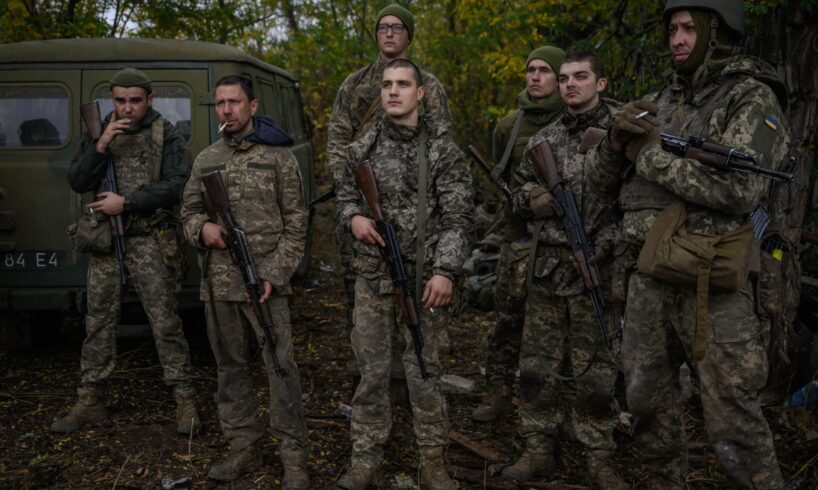
Infantry recruits of the 28th Separate Mechanized Brigade listen to an instructor while undergoing a basic training course at an undisclosed location in eastern Ukraine on Oct. 11, 2025. (Ed Jones / AFP via Getty Images)
A Russian missile strike this week on a Ukrainian training ground — the latest in a series of deadly strikes on training centers across the country — has heightened scrutiny and sparked criticism of the Ukrainian military command’s ability to protect recruits.
Training centers, especially those near the front line or the border, often lack proper air defense, failing to protect recruits from recurring Russian strikes.
While the Ukrainian military claims that it is reassessing its safety protocols after every attack, commanders and former instructors who spoke to the Kyiv Independent argue the Soviet-style culture ingrained in the leadership has hampered its ability to take accountability for what could have been avoidable casualties.
The toll from summer through fall underscores the risks.
A Russian missile strike hit an undisclosed training ground on the morning of Oct. 16, resulting in casualties, Ukraine’s Ground Forces said. Authorities did not disclose the casualty count but expressed condolences to the families of the victims killed.
The October strike follows another Russian attack that struck a training ground in northern Chernihiv Oblast in September, also yielding casualties. In July, a Russian missile strike that hit a training ground in the central city of Kropyvnytskyi killed at least a dozen foreign volunteers fighting for Ukraine, The New York Times reported, citing soldiers who witnessed the attack.
The deadliest attack since the start of the full-scale invasion occurred in March 2022, when a Russian missile strike hit one of Ukraine’s main training centers situated in western Lviv Oblast and killed over 60.
“Training centers are military facilities that should be protected by air defense forces,” Lt. Col. Bohdan Krotevych, the former chief of staff of Ukraine’s Azov Brigade, told the Kyiv Independent.
“This is how the system should work, but there is no system at all in Ukraine’s Armed Forces at the moment,” Krotevych, who has become one of the most vocal critics of the army command, accusing it of mismanagement and negligence, told the Kyiv Independent.
Krotevych suggested questioning Commander-in-Chief Oleksandr Syrskyi, who he believes “is directly responsible for building the system and controlling its existence and effectiveness.”
The General Staff said in a statement to the Kyiv Independent that the safety and health of the personnel, especially when under constant threat of Russian attacks, is its leadership’s “priority attention.”
It stressed that it is thoroughly investigating and analyzing the “cause-and-effect relationships” of the missile strikes at training sites.
“My unconditional demand is to ensure and improve the safety of servicemen,” Syrskyi said in a July Facebook post.
Oleksandr Syrskyi, Commander-in-Chief of the Armed Forces of Ukraine, poses for a portrait in Kyiv, Ukraine, on July 19, 2025. (Oksana Parafeniuk / For The Washington Post via Getty Images)
Ruslan Gorbenko, a lawmaker from the ruling Servant of the People party who regularly travels to the war-torn east and maintains contact with the military, believes that all training should be conducted at least 300 kilometers from the front line, including refresher courses for deployed units. He said Ukraine still uses training centers near the Russian border or not far from the front, despite the danger, because not every military unit has a permanent base in the rear.
Others call for building reinforced facilities. “In my opinion, a strategic program is needed to build underground infrastructure,” Kyrylo Berkal, a deputy commander who oversees training at the 3rd Army Corps, previously the 3rd Assault Brigade, told the Kyiv Independent.
“In general, we need to change our approach to preparation.”
The Ukrainian military largely relies on decades-old training grounds from the Soviet Union, but building new ones would require time and substantial financial resources.
‘Less than a minute’ for missiles to fly in
Oleksandr, a former training center instructor who asked his full name not be disclosed due to concerns over repercussions for speaking up that might affect his current role in the military, acknowledged that the Ground Forces have taken precautionary measures by camouflaging training sites and cancelling gatherings of soldiers, such as those for award ceremonies.
In his view, with Russian reconnaissance drones flying regularly, Moscow can easily determine where the new troops are being trained. This, he says, forces the Ukrainian military to adjust by spreading recruits out to minimize casualties, and by camouflaging centers so that Russian drones cannot easily identify where soldiers are gathered.
Discipline inherited from the Soviet era is “a terrible misfortune” for the Ukrainian army, affecting its ability to analyze and learn from the mistakes, including at training centers.
Oleksandr said that at a training center near the Russian border where he worked up until June, there was either a Russian missile or drone strike “every week.” Though his training center had an anti-drone platoon, which could not protect the troops from incoming ballistic or Kalibr cruise missiles, there have never been casualties among recruits or instructors as of June, he added.
“Every week there is some kind of a hit,” Oleksandr told the Kyiv Independent.
“For us, it (a missile) hits in less than a minute,” he said, stressing how quickly ballistic missiles can hit his former training ground before any warning.
At the training center where Oleksandr worked and the Kyiv Independent visited in October 2024, he said instructors paused training when Russian reconnaissance drones were flying, as they were hunting for potential targets.
Oleksandr said that other safety measures were taken, such as rehearsals of diving into shelters in full gear as quickly as possible and building dugouts so that shrapnel wouldn’t be as deadly in case of a hit. The recruits sometimes have to sit throughout the night at the shelters, waiting for the air raid alerts to lift.
Infantrymen from the operational battalion of the 13th Khartiia Operational Brigade of Ukraine’s National Guard take part in a shooting training session in Kharkiv Oblast, Ukraine, on Aug. 28, 2025. (Viacheslav Madiievskyi / Ukrinform / NurPhoto via Getty Images)
Still, he says new recruits remain vulnerable because they often lack the experience to differentiate the sounds of incoming missiles and drones, so they don’t always know when to seek shelter. This can especially be an issue when there is no air raid alert, especially for training grounds that are close to the missile or drone launching sites.
Ultimately, Oleksandr believes that Ukraine should still use the Soviet-era training facilities, even those close to the border or the front, because it is more practical than building completely new ones.
Preventive measures
No matter the preventive measures, casualties may be inevitable in war when Russia is constantly looking to further reduce Ukraine’s manpower, according to military experts who spoke with the Kyiv Independent.
While the thirst for air defense over training grounds persists, Ukraine’s scarcity of prestigious Western air defense systems – such as the U.S.-made Patriot – and their interceptors has been affecting cities countrywide. With Russia intensifying its attacks using ballistic missiles, even the most protected cities like Kyiv are facing a challenge.
Glen Grant, a retired British Army lieutenant colonel who advised Ukraine’s Defense Ministry on and off from 2014 to 2018, said that pointing fingers for such incidents is “more complex than it sounds.”
While much depends on the quality of the commanders at the training grounds, there is also a limit to how much the officers can disperse the recruits, especially since particular exercises require larger numbers of soldiers and instructors.
“If (Russian forces) target a training area, there almost certainly will be deaths,” Grant told the Kyiv Independent, adding that it is similar to targeting a soccer match with a huge crowd.
Serhiy Hrabskyi, a retired Ukrainian colonel and military analyst, explained that it is difficult to assess whether “everything” was being done to ensure the safety of recruits due to resource constraints, such as for air defense. Both larger boot camp centers far from the front line, such as in western Lviv and Rivne oblasts, and smaller training grounds that belong to individual brigades are targets for Moscow, he added.
Hrabskyi also said that units currently fighting on the front may struggle to allocate resources for their training ground in the rear, making them more vulnerable to Russian reconnaissance drones flying unnoticed.
Krotevych, the former Azov commander, said that many brigades need the training grounds near the front to prepare poorly-trained new troops during deployment “in any way.”
Bohdan “Tavr” Krotevych, then-acting commander of the Azov Brigade, in Kyiv, Ukraine, on March 24, 2023. (Alice Martins / For The Washington Post via Getty Images)
“Only blaming commanders for the responsibility of the personnel’s death and injury is wrong, especially since commanders are also (at these training sites),” Hrabskyi told the Kyiv Independent.
While individual recruits’ discipline comes into play, it is first and foremost up to each training center’s leadership to implement and maintain the safety protocols laid out by the military, according to Serhiy Kuzan, co-founder and chairman of the local think tank Ukrainian Security and Cooperation Center.
“The question is, is (the Ukrainian military leadership) doing all they can?” Grant said, referring to measures such as digging enough dugouts, having a timely warning system, and running drills to go to the shelters.
“And at what point do we have to accept that if we’re putting soldiers together to do training, they will be a legitimate target?”
‘Total lack of critical thinking’
The core issue at training centers, including in terms of safety measures, is the “total lack of critical thinking,” Grant said.
New ideas could be implemented, such as running drills that don’t require a shooting range and changing up the routine regularly to make it harder for Russia to know where to target, he added.
“If you increase the problem for Russia by 50%, you reduce the casualties by 50%,” Grant said.
Hrabskyi agreed that discipline inherited from the Soviet era is “a terrible misfortune” for the Ukrainian army, affecting its ability to analyze and learn from the mistakes, including at training centers. Many commanders also don’t have extensive experience dealing with constant aerial threats, especially since reading about it in textbooks hardly reflects the reality, he added.
Oleksandr and another former instructor, Dmytro, blamed the “Soviet mentality” as the main flaw of the training centers, which they believe prevents the leadership from taking personal responsibility and analyzing how to improve flaws.
Dmytro worked at a training ground throughout 2023 before he said he realized that he could have a greater impact elsewhere, rather than being part of a system that, in his view, poorly prepares recruits..
“The question is also, is the leadership doing something against (casualties caused by Russian attacks on training centers?),” he said, stressing that much depends on the leadership of each training center’s ability to take accountability.
“Unfortunately, we are still in the Soviet Union in this regard,” he said.
However deadly the Russian strikes on training centers may be, Dmytro argued that the cost in lives lost due to poor training is far greater, as Ukraine rushes to fill gaps at the front.
In his experience, new soldiers often lack instructors with combat experience and relevant training for the modern-day battlefield, making them more likely to become casualties after boot camps.
Trump says he hopes to end war without Tomahawks in latest meeting with Zelensky
“Hopefully, we’ll be able to get the war over without thinking about Tomahawks,” Trump told reporters before closed-door talks with Zelensky.





